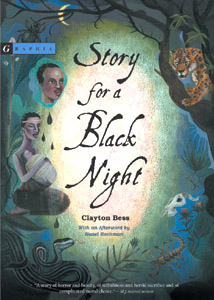
|

Story for a Black Night(Ages 12 up)—Houghton, 1982 An authentic and beautiful, yet tragic tale that transcends national, racial and ethnic boundaries... a tale told by an African father to his son about the disaster that follows a night when a baby with smallpox is abandoned in his family’s home. Bess imaginatively captures the rhythms and cadence of the people’s speech. Voice of Youth Advocates A story of horror and beauty, of selfishness and heroic sacrifice and of complicated moral choice. Told in dialect, the story unfolds with intense drama with new discoveries of betrayal and grace until the very last page. A story for reading together and talking about for a long time. School Library Journal A riveting meditation on the moral choices that must be made in living... starred Booklist The story is taut and tender, deftly structured, vivid in its depiction of the village community as well as of the family. But it is most distinctive in the writing style, which captures the lovely cadence of the language in its dialogue and has the warmth and sonority of the best kind of story-telling it its exposition. A stunning first novel. starred Bulletin of the Center for Children’s Books An unabashed moral tale and a crowd-holding story. starred Kirkus Reviews Story for a Black Night was published in America, France, Mexico and Japan. (If anyone has access to the Japanese edition, please contact me because I have never seen it, and I would love to get at least a picture of its jacket. — 2013 note: Indeed someone did happen upon this request and emailed me the jacket which is now here with a brief note.) In its original 1982 edition, it was named Best First Novel by the Commonwealth Club of California and “A Contribution of Cultural Significance” by the Southern California Council on Literature for Children and Young People. Family Circle named it a Best Book for Kids. In its French edition Par une nuit noire was honored by awards from Diplome Loisirs Jeunes and Selection des Treize. (For an interesting history of the two French translations by Rose-Marie Vassallo, visit the separate page, Par une nuit noire.) All of these awards and starred reviews came as an enormous surprise to me because it had taken me a more than ten long years to find a publisher for this book. Usually I would get the response from editors, “This is good. This is interesting. This is different. This is not right for us.” I would have given up the search for a publisher long before but Sonia Levitin, a prolific author for books for young people and a philanthropist through and through, kept making new contacts for me. And ha! Here in 2009, again a surprise, Sonia has written a letter explaining her devotion to Story for a Black Night. I knew that she loved the story, and because of her persistence in getting the first edition published, I dedicated that 1982 edition to her. But what I didn't know, or not exactly as she tells it in this letter, is how the story first reached her hands, her eyes, her brain, and her imagination, for all of which I am deeply grateful. And thanks to you, too, Auntie Bertie. The illustration at the top of the page is the bookjacket for the first American edition, Houghton Mifflin Company, 1982. The photograph is one I took while I lived in Liberia, but those three people are not the real-life people upon whose story Story for a Black Night was based. Still I liked the photograph, liked the expressions of the faces, and found them apt for my story.
New Edition of Story for a Black NightWhen I read the letter that announced that Story for a Black Night had been named Honor Book for the 2002 Phoenix Award, I literally had to sit down to catch my breath in order to drive home in my brain the implications. Of all the children’s books published in the English language in 1982, my book was chosen for this honor. What this panel of judges was telling me was that this is a book that has “endured” and now might very likely continue to endure. The good scholars at the Children’s Literature Association explained to me that often when a book receives the Phoenix Award or Honor Book—twenty years after its original publication—the book has gone out of print. That is, the publisher has stopped printing copies of the book and it is no longer available for sale. The Phoenix honor often jolts the publisher —or another—to republish the book, giving it new life, like the mythical bird The Phoenix that arises from the ashes to take flight again. This is exactly what happened with Story for a Black Night. With no copies now available to me, and needing a trove of them on hand for my speech at the Children’s Literature Association in June of 2002, I myself published a limited run of 564 copies of a special “Phoenix Honor Edition” through my own company Lookout Press. This 2002 edition is indeed special because it takes my favorite and most apt and intriguing illustrations from both the French edition of Par une nuit noire (1984) and the Mexican edition of Cuento Negro para una Negra Noche (1992) for this new text. For more on each of these editions, click the links below. Phoenix Honor Edition To my huge surprise, I found as I was doing the retyping in preparation for publishing my Phoenix Honor edition that I had omitted from the 1982 Houghton edition an incredibly significant piece of the story, one of the grisliest and most core incidents of this factually based story, which was told to me by the mother of one of my students. I still cannot account for this omission. I’m sure that it wasn’t intentional because it was always a part of my presentations of this book in schools all over the United States. Well, I don’t know how that got lost for twenty years from the written word, while it lived on in the oral word, but that was a huge bonus in bringing out the new edition; it gave me the opportunity to find a way to fit it back in. Another wonderful aspect of the Phoenix Honor for Story for a Black Night is that the French translator, Rose-Marie Vassallo, with whom I became good friends after her 1984 translation of Par une nuit noire, told me that she wanted to have a stab at a new translation. She told me that she had never really been satisfied with her decision as to how to handle the dialect in the first person narrative. The dialect is mentioned favorably in all the reviews because it adds so much to the storytelling. I remember when Rose-Marie was working on the first French translation, I asked her how she intended to handle the problem of dialect—would she, for example, try to achieve a French West African dialect such as one might find in Ivory Coast or Guinea, both of which border Liberia? Rose-Marie said no. She said that the original English text appeared to her to be rather “elevated” by the use of the dialect, whereas a French-African dialect might tend, in her opinion, to diminish the narrative. She decided instead, in that first translation, to use a very pure and simple French to try to approach the same effect. However—twenty years later—Rose-Marie felt that she had grown as a translator and might now “have the chops” to try to achieve a similar dialectical effect and so she volunteered—such an honor for me! and such a sign of our friendship!—to start from scratch and provide a completely new translation. She did this with some trepidation all through the work because she found that the closer she got to achieving her own French-African voice, the further she had to stray from my own English-African original. What an interesting phenomenon. Another significance of the Phoenix Honor is that the original publisher, Houghton Mifflin Company in Boston, decided to do a new paperback edition of Story for a Black Night, so that this wonderful book is again in the bookstores. As a result, many students recently writing papers on Story for a Black Night have emailed me questions, which I have been happy to answer. Most of these questions involve my years in the Peace Corps, how this story came to me, why I decided to write the book from the point of view of Momo, what considerations went into the dialect, what revisions I made in the 2002 edition and why. To read all questions, click Q and A.
|
